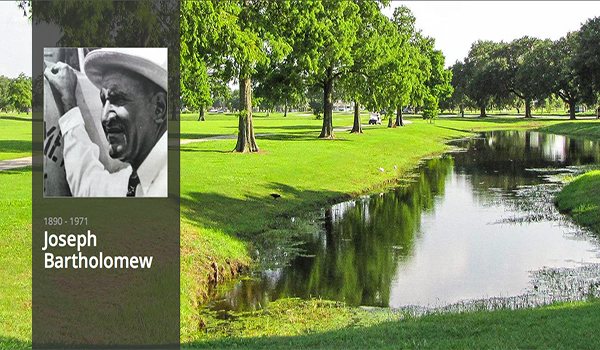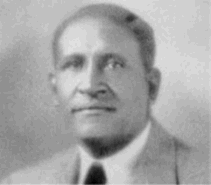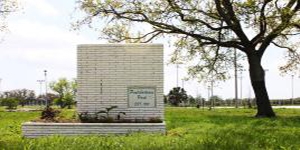June 30, 2017 | BY AAGD STAFF
Joseph M. Bartholomew was an African American golfer who specialized in designing golf courses. He was born on August 1, 1885 in New Orleans, Louisiana and became the first African American man to ever build a public golf course. At the age of seven, he worked as a caddie at the Audubon Golf Course that was located near his home. Eventually, Bartholomew became a greenskeeper at the course.
While working as a hired assistant to Scottish-American professional golfer Fred McLeod, Bartholomew learned how to make golf clubs. A keen observer, as he caddied, Bartholomew mimicked the swings of the golfers he caddied for, literally teaching himself how to hit the ball. As he became more skilled at playing he began to teach others. He became so good at the sport (at one time shooting 62 at the Audubon course) until club members began to arrange matches for him and placed their wagers on his rounds.
After several years, Bartholomew branched out across town to Metairie Golf Club, where he met a wealthy club member named H. T. Cottam who persuaded the club to send Bartholomew to Long Island, New York to obtain knowledge and experience in golf course architecture. There he learned course design with golf course architect Seth Raynor. Raynor was well-known in the industry and had built his first course in 1914, at age 28. The Southhampton engineer would go on to build over 100 courses and become the creator of the National Golf Links of America.
Bartholomew learned his craft well from Raynor and early in 1922, he returned to New Orleans where he started construction of Metairie’s new golf course. The land on the site that had been selected was pure untouched wilderness. Bartholomew cleared the land and often worked overnight on the Metairie project in order to protect his design ideas from those who might steal them. The added precaution that he took highly disturbed club members at Metairie, and they demanded assurance that their investment money was being spent wisely.
With the pressure from investors building, Bartholomew took action early one morning, loaded his doubters into wagons and showed them the progress that he was making in developing the course. Upon arriving at the site they were overwhelmed by what they saw. They left Bartholomew to complete his work and increased his salary. The project was finally finished after several long months of physical labor and mental anguish. However, because of the laws of segregation, it’s creator, Bartholomew, wasn’t even allowed to hit one single golf ball on the fine Metairie golf course that his mind and hands had shaped.
After the course opened, he began teaching and making golf clubs there for a few years. Afterward, Bartholomew went to work as a greenkeeper at New Orleans Country Club, staying only a short time before he was hired in 1933 to design New Orleans’ City Park No. 1 course with landscape architect William Wiedorn. Bartholomew designed and built Pontchartrain Park’s golf course, which opened in 1956. The course was named in his honor in 1979. City Park’s North course, which opened in 1968, was also designed by Wiedorn and Bartholomew. Bartholomew designed and constructed additional courses in several cities that included Covington, Hammond, Abita Springs, Algiers, and Baton Rouge, Louisiana, as well as one course in Mississippi. Due to segregation, Bartholomew could only enjoy his creations from afar, but unable to play them.

Joseph M. Bartholomew, Sr. Golf Course, New Orleans, Louisiana. 18 hole regulation length course, Municipal golf course, 72 par, 6,823 yards, 101 slope 68.5 rating.
Bartholomew’s work in golf course design may have excelled even further, however, even with the racism of his time over the next decade, he built a number of other courses in Louisiana, including City Park No. 1, City Park No. 2, and Pontchartrain Park in New Orleans. The public golf courses, like all of the city park playgrounds, were segregated and off limits for use by blacks. And although Bartholomew had built them too, he could not play them. According to all accounts, Bartholomew received little, if any, compensation for building the three New Orleans courses. Financially, he earned his greatest payoff from building seven golf holes primarily for his friends, on property that he owned in the New Orleans suburb of Harahan. This African American-owned, designed and built golf course gave blacks a place to play the game. Later, Bartholomew started his own construction company and expanded his business into other areas, including landscaping, real estate investment, and asset diversification.
Over the years his wealth grew and he contributed money to Dillard and Xavier Universities. In his later years, wise yet aged, Joe Bartholomew was a fixture at Pontchartrain Park. In his 70’s, with his health declining, even the mention of the game of golf would light up his eyes. On Oct. 12, 1971 Bartholomew suffered a stroke and died. The following year, his significant contributions to the game of golf were recognized when he became the first African American to be inducted into the Greater New Orleans Sports Hall of Fame.





